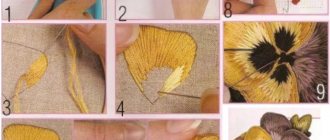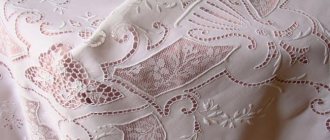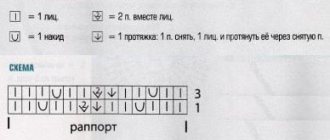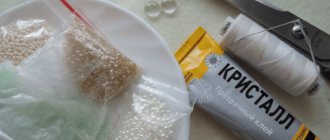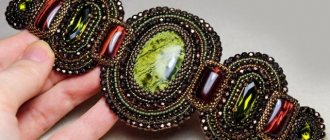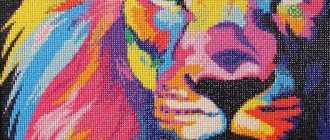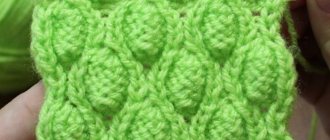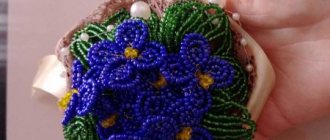Options for techniques and stitches for embroidery on linen
In the production of underwear, various meshes, tulles, artificial and natural silks, often with the addition of elastane, thin knitwear, cotton and synthetic lace are mainly used. Basically, these are thin and most often elastic fabrics.
There are many options for techniques and stitches for embroidery on linen suitable for such fabrics. I will write about those that seem most interesting to me.
1. Embroidered with beads, sequins and other accessories on smooth and lace details of lingerie
Sewing drops. Drops are glass beads in the form of drops.
This technique should be used in lingerie that you do not plan to put anything on top of (possibly running beads under clothes) or on clothes for the house.
2. Repeating samples (repeating pattern)
Embroidery samples with drops
This can be a three-dimensional element made of accessories or a flower made of threads, which can be rhythmically repeated or randomly scattered throughout the product.
3. Seam “back with a needle”
They can embroider any contour element. A phrase or word, a leaf, a feather, a beetle, berries, whatever comes to mind depending on your mood.
Embroidering an asterisk with a “back needle” seam
Embroidering an inscription using a “back needle” seam
4. French knot
A simple and effective technique.
French knot
All experiments were carried out using a garter belt from Agent Provocateur.
Features of embroidery on knitted items
Before you start embroidering knitted items, you should study the technical points:
- pattern diagrams;
- embroidery technique;
- types of seams.
Embroidery on knitted items
To make the item look beautiful with finishing and not untidy, you should try applying simple embroidery to a sweater. This will allow not only the novice needlewoman to get her hands on, but also create an interesting finish on the item.
Additional Information! For embroidery on knitwear, you should use a special water-soluble fabric. It can be attached to an item using a hoop or pins. After finishing the work, the finished product is dipped into slightly soapy water, where the fabric dissolves and the jacket acquires an interesting ornament. This little thing is very useful for sewing numbers.
Honeycomb embroidery technique
Honeycomb - embroidery on knitted fabric, imitating lush puffs. This technique is used for finishing the neckline, cuffs, and the bottom of the product. Most often, threads of the same tone as the knitted item are used.
Honeycomb
All work is done step by step with small stitches. A needle is inserted into the first point, then into the second and the thread is pulled out, after which the needle is inserted into the third point and returns to the second and is pulled out together with the thread. The thread must be pulled tightly, and then the last action must be repeated with 2 and 3 points. After this, the needle is stuck into the last point and pulled to 4 and later to 5. The thread is pulled tightly along this fragment, after which the embroidery process continues from the fifth point. Using the same technique, work continues until the first honeycomb is formed, after which the first point of the second and subsequent fragments is determined.
Knitted product with honeycomb
Italian seam
Among the huge variety of techniques for applying patterns on knitwear, the Italian seam is considered the brightest and most elegant option for creating a unique picture on a product. Very fluffy yarn is selected for the work; smooth threads do not give the chic and expressiveness that is inherent in it.
Italian seam
The thread is fastened to the wrong side of the jacket, then the needle is brought out to the front side, two loops are pierced perpendicular to the main direction. After this, the needle is inserted under the loop itself; the action must be performed carefully so as not to snag the item itself. The thread is passed around the needle and again stuck into the loop, which is formed thanks to the crossed threads.
Zigzag chain stitch
The chain stitch technique is one of the few that allows you to “overlay” a crochet embroidery pattern on a knitted fabric, as well as carry out this procedure using a needle.
There are many varieties of chain stitch:
- Closed - used in Indian ornaments.
- Intertwined - chain stitch with Spanish coral motifs.
- Cirrus - also called “herringbone”. Used for embroidering contrasting patterns or edging complex patterns.
- Tight - a simple chain stitch using a thick thread, most often wool.
- Wide - represents a clear, wide line. This seam is used to highlight the outline of a picture on a product.
- Two-color - the ornament is embroidered in two colors at the same time. The result is a contrasting pattern.
- Zigzag - suitable for finishing sleeves, the bottom of the product, the more magnificent the thread, the more beautiful the item will look.
You might be interested in Creating an embroidery machine with your own hands
In recent years, embroidery on knitted items using the zigzag chain stitch technique has begun to regain its popularity. Easily created curved lines from loops will complete the overall composition depicted on a children's sweater of any model.
Zigzag chain stitch
To work, you need to place the thread on the canvas, visually drawing two parallel lines. The loops must be placed exactly within their boundaries. The first stitch is made from the top. The needle is inserted at an angle, and then brought out on one of the lines, the thread is pulled out. A chain stitch is made. The next step is the second stitch, but it is done in the opposite direction, i.e. a thread is pulled out from the center to the other side. So alternately, first to one line, then to the other, the needle and thread are brought out.
Important! The main point in this type of embroidery is slowness. The slower and smaller the stitch, the neater the work will be.
Types of chain stitches
What you need for embroidery
Minimum set:
- small hoops,
- thin hand needles,
- disappearing pencil for drawing,
- scissors,
- threads
For our purposes, floss and any other sewing threads that you like in color and texture will be suitable. The only thing worth checking is whether they are painted.
One day, the silk threads I used to outline the design dyed the base fabric. Such stains practically cannot be washed off. Therefore, soak the thread you are going to use in hot water, lather it and press it onto the cotton scrap. If there are no traces left, feel free to use it.
To attach the fittings, use thin, strong threads, for example, Madeira No. 120 100% Polyester in the color of the fittings being sewn.
We tie a knot. We wind the thread onto the needle and lower it to the end of the thread.
A set of accessories for one part of the sample
Sewing on accessories
Do not use threads with lurex, nylon, or wool for embroidery. If you do not cover the reverse side, and this is almost impossible to do on ready-made underwear, these threads will cause discomfort when in contact with the skin.
Choose threads depending on the material on which you plan to embroider. Pay attention to consistency of density. A thin silk thread on textured, voluminous knitted socks will get lost, and a coarse thread on tulle will most likely look out of place.
Beadwork
For such embroidery you can use any kind, but it is best to use cotton ones. The piece of thread should not be very large (up to 40 cm), so it will be less tangled.
Bead embroidery on knitted items
Important! For better glide and to avoid tears, the thread can be lubricated with wax.
When embroidering on knitted items, it is best to use threads in two folds, choosing them to match the tone of the beads themselves. Each bead must be slightly recessed in the loops, this will make the pattern more delicate and uniform.
Except threads
You can embroider on underwear not only with threads: the product can be decorated with beads, beads, sequins, rhinestones, and cords. It can be anything. Be bolder. If you don’t like the result, you can flog everything.
Sewing on large sequins
Demonstration of embroidery with large sequins
All fittings should also be checked for color fastness under water. As a rule, nothing happens to it when it comes into contact with water. But you cannot iron embroidery areas using sequins.
Decorating knitwear with embroidery with woolen threads
You can embroider a pattern on any knitwear item. You should choose the same threads as those from which the fabric is knitted. They can be thinner, but not thicker than the main ones. For the convenience of applying the design, dublinin or lining is used in this place from the wrong side .
You can replace them with a special canvas, which will prevent shrinkage and help apply the pattern more evenly; it will dissolve after washing. The needles used are thick and blunt so as not to damage the fabric. Ribbons, beads or sequins are often added to embroidery with wool threads.
Important! Knitted fabric stretches well, but after embroidery it loses this property.
Three-dimensional patterns with woolen threads can be used on mittens, socks, blouses and children's clothes. There are many ornaments and various patterns for decorating knitted items. Volumetric embroidery with woolen threads on knitting is an excellent stylish decor.
Where to learn embroidery
Embroidery on underwear is not too different from embroidery on clothing. If you want to learn how to embroider professionally, then I recommend the place where I studied myself. This is an embroidery school at the Yaroslavl Embroidery Factory. There are courses in couture embroidery and world experience, as well as professionally structured programs.
Among foreign schools, I would recommend Ecole Lesage. I plan to take a course with them in the fall. This is the most famous embroidery school located in Paris.
There are different courses for different levels. Professionals will most likely be interested in a school based on the Lesage embroidery studio, which carries out orders for many legendary fashion houses. Now the atelier has been bought by Chanel.
Pros and cons of embroidery on knitted items
On the Internet you can find information that embroidery on knitted fabric is one of the simplest embroidery options. This is a very big misconception, especially for those authors of articles who themselves have never held a needle and thread in their hands. Very few girls and women of modern society have the skills of knitting, sewing, embroidery or other types of needlework. Today you can buy ready-made needlework kits with patterns, and there are many video tutorials online that will allow you to create an elegant pattern on things.
Before you begin the process of embroidery on knitted items, you should decide on the technique and study the types of seams that can be used in your work. For beginners in embroidery, you should choose simple patterns to get your hands on. At the same time, the design should be “applied” to the item carefully so that the product receives additional chic and does not resemble an untidy little thing. An interesting and unique decor created independently for your “warm” wardrobe will allow you to look stylish and expensive even in the harshest weather.
Where to look for inspiration
People who inspire me are Björk's costume designer James Merry. He doesn't embroider on underwear, but he has a famous series of embroideries on sports jerseys from famous brands that can inspire. He also posts videos of his cat in stories and views of Iceland.
detail of embroidered headpiece for @bjork


